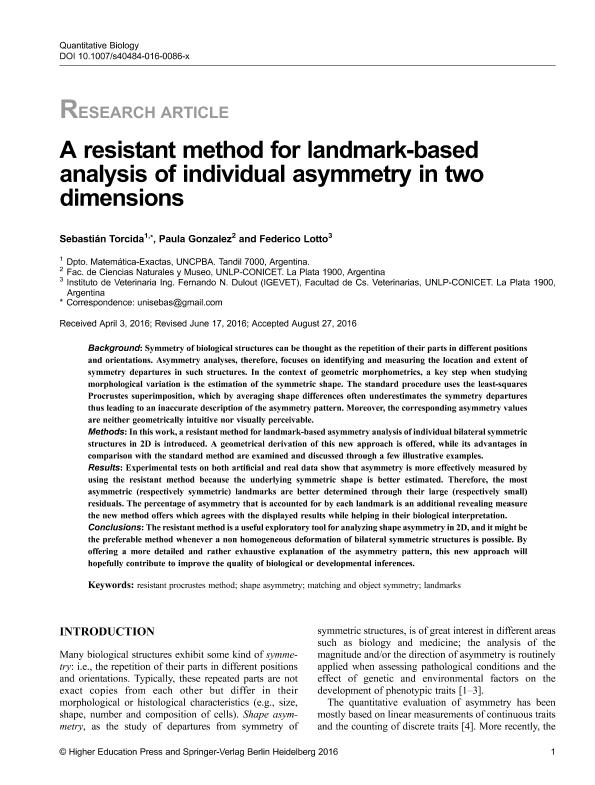Mostrar el registro sencillo del ítem
dc.contributor.author
Torcida, Sebastián

dc.contributor.author
Gonzalez, Paula Natalia

dc.contributor.author
Lotto, Federico Pablo

dc.date.available
2018-12-11T19:47:00Z
dc.date.issued
2016-12
dc.identifier.citation
Torcida, Sebastián; Gonzalez, Paula Natalia; Lotto, Federico Pablo; A resistant method for landmark-based analysis of individual asymmetry in two dimensions; Springer; Quantitative Biology; 4; 4; 12-2016; 270-282
dc.identifier.issn
2095-4697
dc.identifier.uri
http://hdl.handle.net/11336/66293
dc.description.abstract
BackgroundSymmetry of biological structures can be thought as the repetition of their parts in different positions and orientations. Asymmetry analyses, therefore, focuses on identifying and measuring the location and extent of symmetry departures in such structures. In the context of geometric morphometrics, a key step when studying morphological variation is the estimation of the symmetric shape. The standard procedure uses the least-squares Procrustes superimposition, which by averaging shape differences often underestimates the symmetry departures thus leading to an inaccurate description of the asymmetry pattern. Moreover, the corresponding asymmetry values are neither geometrically intuitive nor visually perceivable.MethodsIn this work, a resistant method for landmark-based asymmetry analysis of individual bilateral symmetric structures in 2D is introduced. A geometrical derivation of this new approach is offered, while its advantages in comparison with the standard method are examined and discussed through a few illustrative examples.ResultsExperimental tests on both artificial and real data show that asymmetry is more effectively measured by using the resistant method because the underlying symmetric shape is better estimated. Therefore, the most asymmetric (respectively symmetric) landmarks are better determined through their large (respectively small) residuals. The percentage of asymmetry that is accounted for by each landmark is an additional revealing measure the new method offers which agrees with the displayed results while helping in their biological interpretation.ConclusionsThe resistant method is a useful exploratory tool for analyzing shape asymmetry in 2D, and it might be the preferable method whenever a non homogeneous deformation of bilateral symmetric structures is possible. By offering a more detailed and rather exhaustive explanation of the asymmetry pattern, this new approach will hopefully contribute to improve the quality of biological or developmental inferences.
dc.format
application/pdf
dc.language.iso
eng
dc.publisher
Springer

dc.rights
info:eu-repo/semantics/openAccess
dc.rights.uri
https://creativecommons.org/licenses/by-nc-sa/2.5/ar/
dc.subject
Resistant Procrustes Method
dc.subject
Shape Assymetry
dc.subject
Matching And Object Symmetry
dc.subject
Landmarks
dc.subject.classification
Matemática Pura

dc.subject.classification
Matemáticas

dc.subject.classification
CIENCIAS NATURALES Y EXACTAS

dc.title
A resistant method for landmark-based analysis of individual asymmetry in two dimensions
dc.type
info:eu-repo/semantics/article
dc.type
info:ar-repo/semantics/artículo
dc.type
info:eu-repo/semantics/publishedVersion
dc.date.updated
2018-11-26T13:32:19Z
dc.identifier.eissn
2095-4689
dc.journal.volume
4
dc.journal.number
4
dc.journal.pagination
270-282
dc.journal.pais
Alemania

dc.description.fil
Fil: Torcida, Sebastián. Consejo Nacional de Investigaciones Científicas y Técnicas; Argentina. Universidad Nacional del Centro de la Provincia de Buenos Aires; Argentina
dc.description.fil
Fil: Gonzalez, Paula Natalia. Consejo Nacional de Investigaciones Científicas y Técnicas. Centro Científico Tecnológico Conicet - La Plata; Argentina. Universidad Nacional de La Plata. Facultad de Ciencias Naturales y Museo; Argentina
dc.description.fil
Fil: Lotto, Federico Pablo. Consejo Nacional de Investigaciones Científicas y Técnicas. Centro Científico Tecnológico CONICET- La Plata. Instituto de Genética Veterinaria "Ing. Fernando Noel Dulout". Universidad Nacional de La Plata. Facultad de Ciencias Veterinarias. Instituto de Genética Veterinaria; Argentina
dc.journal.title
Quantitative Biology
dc.relation.alternativeid
info:eu-repo/semantics/altIdentifier/url/https://link.springer.com/article/10.1007/s40484-016-0086-x
dc.relation.alternativeid
info:eu-repo/semantics/altIdentifier/doi/https://doi.org/10.1007/s40484-016-0086-x
Archivos asociados
